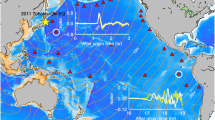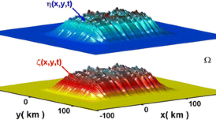Abstract
The March 11, 2011, megaquake caused a catastrophic tsunami recorded throughout the Pacific. This paper presents an analysis of the sea-level records obtained from deep-water tsunami meters (DART and NEPTUNE). To evaluate the effect of the sea-level oscillations’ decay, a statistical analysis of observations and numerical modeling of tsunami generation and propagation have been conducted. The main goal is to uncover physical mechanisms of the tsunami wave field formation and evolution at scales up to tens of thousands of kilometers in space and a few days in time. It is shown that the tsunami lifetime is related to the wave-energy diffusion and dissipation processes. The decay time of the variance of the tsunami-generated level oscillations is about 1 day. Multiple reflections and scattering by irregularities of the bottom topography make the field of the secondary tsunami waves stochastic and incoherent: the distribution of the wave energy in the ocean reaches a statistical equilibrium in accordance with the Rayleigh-Jeans law of equipartition of the wave energy per degree of freedom. After the tsunami front has passed, the secondary-wave energy density turns out to be inversely proportional to the water depth.
Similar content being viewed by others
References
W. H. Munk, “Some comments regarding diffusion and absorption of tsunamis,” in Proc. Tsunami Meetings, 10th Pacific Science Congress, IUGG Monograph 24 (Paris, 1963), pp. 31–41.
S. A. Ermakov and E. N. Pelinovsky, “Anomalous attenuation of tsunamis in a stratified ocean with statistically rough bottom,” Izv. Akad. Nauk SSSR, Fiz. Atmos. Okeana 15(6), 662–668 (1979).
A. B. Rabinovich, L. I. Lobkovsky, I. V. Fine, R. E. Thomson, T. N. Ivelskaya, E. A. Kulikov, “Near-source observations and modeling of the Kuril Islands tsunamis of 15 November 2006 and 13 January 2007,” Adv. Geosci. 14, 105–116 (2008).
F. Imamura, “Review of tsunami simulation with a finite difference method,” in Long-Wave Run-up Models, Ed. by H. Yeah, P. Liu, and C. Synolakis (World Scientific, London, 1996), pp. 25–42.
Y. Okada, “Surface deformation due to shear and tenisle faults in a half-space,” Bull. Seismol. Soc. Am. 75, 1135–1154 (1985).
G. Hayes, Finite Fault Model. Updated Result of the Mar 11, 2011 M w 9.0 Earthquake Offshore Honshu, Japan, 2011. http://earthquake.usgs.gov/earth-quakes/eqinthenews/2011/usc0001xgp/finite_fault.php.
Z. Kowalik, J. Horrillo, W. Knight, and T. Logan, “Kuril Islands tsunami of November 2006: 1. Impact at Crescent City by distant scattering,” J. Geophys. Res. Oceans 113, C01020 (2008). doi: 10.1029/2007JC004402
K. Kajiura, “The leading wave of a tsunami,” Bull. Earthquake Res. Inst., Univ. Tokyo 41(3), 535–571 (1963).
I. V. Fine and E. A. Kulikov, “Calculation of sea surface displacements in a tsunami source area caused by instantaneous vertical deformation of the seabed due to an underwater earthquake,” Vychisl. Tekhnol. 16(2), 111–118 (2011).
M. A. Nosov and S. V. Kolesov, “Optimal initial conditions for simulation of seismotectonic tsunamis,” Pure Appl. Geophys. 168(6–7), 1223–1237 (2011).
A. B. Rabinovich, R. N. Candella, and R. E. Thomson, “The open ocean energy decay of three recent trans-Pacific tsunamis,” Geophys. Res. Lett. 40 (2013). doi: 10.1002/grl.50625
T. Saito, D. Inazu, S. Tanaka, and T. Miyoshi, “Tsunami coda across the Pacific Ocean following the 2011 Tohoku-Oki earthquake,” Bull. Seismol. Soc. Am. 103(2B), 1429–1443 (2013).
B. W. Levin and M. A. Nosov, Physics of Tsunami and Related Phenomena in the Ocean (Yanus-K, Moscow, 2005) [in Russian].
W. G. van Dorn, “Some tsunami characteristic deducible from tide records,” J. Phys. Oceanogr. 14, 353–363 (1984).
T. H. Bell, “Statistical features of sea-floor topography,” Deep-Sea Res. 22, 883–892 (1975).
G. V. Shevchenko and V. N. Patrikeev, “Statistical characteristics of abyssal roughnesses in the northwestern part of the Pacific Ocean and their possible impact on the character of tsunami propagation,” Tikhookean. Geol. 31(6), 44–48 (2012).
I. V. Fine, E. A. Kulikov, and J. Y. Cherniawsky, “Japan’s 2011 tsunami: Characteristics of wave propagation from observations and numerical modelling,” Pure Appl. Geophys. 170(6–8), 1295–1307 (2012). doi: 10.1007/s00024-012-0555-8
F. R. S. Rayleigh, “Remarks upon the law of complete radiation,” Philos. Mag. 49, 539–540 (1900).
J. H. Jeans, “On the partition of energy between matter and aether,” Philos. Mag. 10, 91–98 (1905).
E. A. Kulikov, “Measurements of the ocean level and tsunami forecast,” Meteorol. Gidrol., No. 6, 61–68 (1990).
Author information
Authors and Affiliations
Corresponding author
Additional information
Original Russian Text © E.A. Kulikov, I.V. Fine, O.I. Yakovenko, 2014, published in Izvestiya AN. Fizika Atmosfery i Okeana, 2014, Vol. 50, No. 5, pp. 567–577.
Rights and permissions
About this article
Cite this article
Kulikov, E.A., Fine, I.V. & Yakovenko, O.I. Numerical modeling of the long surface waves scattering for the 2011 Japan tsunami: Case study. Izv. Atmos. Ocean. Phys. 50, 498–507 (2014). https://doi.org/10.1134/S0001433814050053
Received:
Accepted:
Published:
Issue Date:
DOI: https://doi.org/10.1134/S0001433814050053




